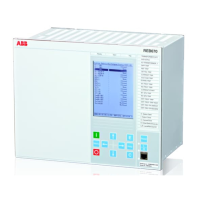and normally closed (that is, "a" and "b" contacts) auxiliary contacts from the busbar
disconnectors are available to the IED.
If for a particular CT input setting parameter ZoneSel is set to Ctrl_Excludes, then this
CT input will be:
• excluded from the dif
ferential zone A when input signal CTRLZA on
corresponding bay block is given logical value one and it will be included to the
differential zone A when input signal CTRLZA on corresponding bay block is
given logical value zero
• excluded from the differential zone B when input signal CTRLZB on
corresponding bay block is given logical value one and it will be included to the
differential zone B when input signal CTRLZB on corresponding bay block is
given logical value zero.
This setting is typically used for feeder bays in double busbar single breaker stations in
order to form proper busbar disconnector replica. It is especially suitable when only
normally closed (that is, “b” contact) auxiliary contact from the busbar disconnector(s)
is available to the IED. For more information please refer to Figure
64.
6.1.3.6 CT disconnection for bus interconnector CT cores
M12113-3 v4
For simplicity purpose, sometimes we also refer to a bus-section or bus-coupler bay as
a bus interconnector bay
. In practice there are three different solutions for bus
interconnector bay layout. First solution is with two sets of main CTs, which are
located on both sides of the circuit breaker, as shown in Figure
46.
ZA
21 8
ZB
21 8
BS
en01000013_ansi.vsd
ANSI01000013 V1 EN-US
Figure 46: Example of station with two sets of main CTs in the bus-section bay
Section 6 1MRK 505 370-UUS A
Differential protection
122 Busbar protection REB670 2.2 ANSI
Application manual

